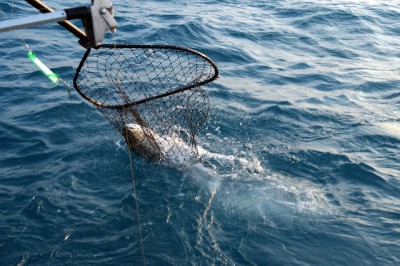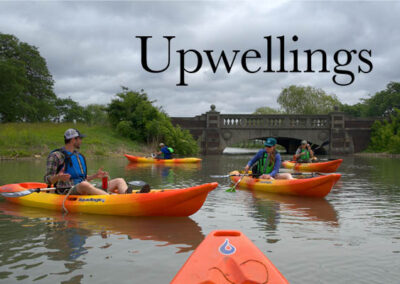Fisheries managers issued a new proposal to reduce stocking of Chinook salmon and lake trout. Anglers should get the facts before deciding how to react.

By Dan O’Keefe
Many anglers, charter captains, and community leaders along the shores of Lake Michigan are wondering how a reduction in Chinook salmon stocking might affect fishing and tourism. Some question the need for a stocking reduction, some believe that stocking of another predator (lake trout) should also be reduced, and many are reporting that this year’s fishing has been a big improvement over 2015.
In June, fisheries agencies issued a proposal to reduce Chinook salmon stocking in Lake Michigan by 62 percent. That proposal was recently revised to include a 50 percent reduction in Chinook salmon stocking and additional measures to decrease lake trout stocking by about 21 percent and increase lake trout harvest. The Michigan DNR will host public meetings on Sept. 7 in Ludington and Sept. 13 in South Haven to discuss details of the revised proposal and hear comments.
Before forming an opinion on the new proposal it is worth considering the latest science on the state of the Lake Michigan fishery.
Most Chinook salmon caught in Lake Michigan are wild
According to the U.S. Fish & Wildlife Service’s Great Lakes Mass Marking Program, wild-spawned Chinook salmon made up 71 percent of the Chinook catch for Michigan anglers in 2014-2015. In Wisconsin waters, wild Chinooks made up 53 percent of the catch.
Even ports that are not near spawning rivers rely mostly on wild fish
Grand Haven is a good example of a southern Michigan port that does not support natural reproduction. Volunteers with the Salmon Ambassadors program found that 74 percent of Chinook salmon caught in the Grand Haven area in 2015 were wild. More than 90 percent of the stocked fish caught in Grand Haven were stocked elsewhere.
Alewife are at a historic low
The USGS Great Lakes Science Center’s bottom trawl survey found that yearling and older alewife biomass density dropped to 0.14 kg/ha in 2015, the lowest since monitoring began in 1973. This does not mean that alewife completely disappeared from the lake, but it does mean that less food is available for predators in open water. Also, Age 8 alewife were once common, but no alewife over Age 6 were found in 2015 surveys.
Last year the fishery appeared to be on the brink of disaster
The Predator-Prey Ratio for Chinook salmon and alewife was 0.108 in 2015. This means less than ten pounds of prey per pound of predator in Lake Michigan, which is similar to Lake Huron before the collapse. Ecosystems cannot support such a predator-prey imbalance for very long. Although the situation may have improved this year judging by angler reports, the Predator-Prey Ratio is based on a variety of data sources that take time to collect and analyze. The ratio for 2016 probably will not be available until March of 2017.
Chinook salmon eat more prey fish than lake trout
According to Michigan DNR consumption estimates, lake trout consumption of prey fish rose from 14.9 kilotons (kt) in 2011 to 23.1 kt in 2015. However, Chinook salmon consumption is still higher than lake trout (33.1 kt). Anglers and biologists realize that lake trout are increasingly important in terms of their impact on prey fish, but Chinooks are still “kings” when it comes to bait consumption.
Lake trout do not eat more alewife than Chinook salmon
Chinook diet is around 95 percent alewife while lake trout diet is typically 60 percent alewife or less, so in 2015 Chinook salmon consumed over 30 kt of alewife in Lake Michigan while lake trout consumed less than 14 kt of alewife.
Lake trout are not entirely dependent on alewife
According to a recent USFWS stable isotope study, lake trout rely more heavily on offshore bottom-dwelling prey than Chinooks do. Sculpin and goby are examples of bottom-dwelling fish have been doing better than alewife since the invasion of quagga mussels and related food web changes.
Lake trout are not managed by the federal government
A federal agency (U.S. Fish & Wildlife Service [USFWS]) does rear lake trout in hatcheries, but does not ultimately make decisions regarding the total number of lake trout stocked in Lake Michigan. State and tribal agencies on the Lake Michigan Committee (under the auspices of the Great Lakes Fishery Commission) arrive at consensus on stocking decisions.
The 2000 Consent Decree does influence stocking, harvest, and management of a variety of fish species in 1836 Treaty waters. The USFWS is a party to the 2000 Consent Decree along with five tribes and the state of Michigan, and the USFWS is also a member of the Technical Fisheries Committee. The role of USFWS is to provide technical assistance. Management decisions are made by state and tribal governments.
Stocking in public waters of Michigan must ultimately be approved and permitted by Michigan Department of Natural Resources. However, lake trout stocking in northern Lake Michigan portions of the 1836 Treaty waters is required by the 2000 Consent Decree to reflect an “expanded commitment to lake trout rehabilitation” and avoid lowering the established lake trout harvest limit.
Lake trout stocking was already being reduced as of 2015
In 2015, the Lake Michigan Committee approved a lake trout stocking reduction of 550,000 fall fingerlings (220,000 yearling equivalents). This reduction is being implemented in fall of 2016 independent of any Chinook salmon cut or additional measures related to lake trout.
The role of science
No matter which side of the argument you are on, it is important to support your position with the best available information. All of the statements above are based on the best available scientific information – but scientists will be the first to point out that “best available” does not mean perfect. Science is always improving, and scientists are always looking for better ways to make sense of patterns in the natural world.
Understanding the best available science is only the first step toward good decision-making, but it is an important one. Science does not dictate or result in a specific decision, but it can inform us of the risk associated with different options. In this case, we face a greater risk of alewife and salmon collapse over the long term if we do not reduce stocking. In the short term, severe stocking cuts could have a noticeable effect on catches in some areas of the lake. Good science will help us assess the relative risks, but ultimately we must decide which risks are acceptable and which are not.
Michigan Sea Grant helps to foster economic growth and protect Michigan’s coastal, Great Lakes resources through education, research and outreach. A collaborative effort of the University of Michigan and Michigan State University and its MSU Extension, Michigan Sea Grant is part of the NOAA-National Sea Grant network of 33 university-based programs.


